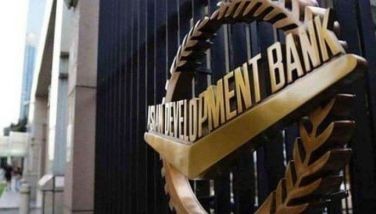YEARENDER:Phl economy shows strong resilience, sustains momentum
MANILA, Philippines - Despite the overwhelming task of rebuilding following a powerful typhoon that ripped through the Visayas region, the Philippines showed great resilience and managed to sustain its growth momentum in 2014, albeit at a slower pace, as the government continued to step on the brakes on public spending.
Once known as the “sick man of Asia,” the Philippines has pulled through admirably to remain one of the fastest-growing economies in the region, owing to improvements in fiscal management and the Aquino administration’s good governance initiatives.
Since President Aquino came into office in 2010, the Philippines has witnessed an unprecedented period of macro-economic buoyancy which allowed it to attract greater foreign investments and win investment-grade ratings.
In 2013, the country expanded 7.2 percent to make it the second best-performing economy in Asia after China, driven by the robust services and industry sector as well as strong household consumption.
Thanks to the steady influx of remittances from millions of Filipinos working abroad as well as investments from business process outsourcing companies, the Philippines defied a regional slowdown which saw China’s economy slumping to its slowest pace of growth since the global financial crisis.
Effects from a slowdown in the world’s second largest economy have trickled through to South Korea, Hong Kong, Singapore and Indonesia.
Stable remittances from Filipino overseas workers have provided a strong foundation for a healthy buildup of international reserves, which stood at $79 billion as of the end of November. The amount is equivalent to 8.3 times the country’s short-term external debt based on original maturity.
The Philippine economy, however, slowed sharply in the third quarter — its weakest pace of growth since 2011 — due to anemic public spending, poor agricultural performance and port congestion.
State underspending remains an acute problem that could jeopardize President Aquino’s goal of boosting annual expansion to as much as 8.5 percent by the end of his term in 2016.
While the government spent six percent more in the nine months through September than the same period a year earlier, the amount was still 16 percent less than programmed.
Underspending by the government has been estimated at P274 billion in first nine months of 2014 alone.
Government expenditure has further weakened after the Supreme Court declared unconstitutional certain portions of the government’s Disbursement Acceleration Program (DAP), a fund allocation scheme intended to pump-prime the economy and address government underspending.
Last July 1, the high court unanimously voted to partially void DAP, saying it was unlawful to take unspent funds from projects that took time to be implemented and transfer these from one government branch to another.
According to the Supreme Court, the DAP encroached on congress’ exclusive power to appropriate funds.
The pullback in spending reflects the cautious stance by government agencies amid concerns over the misuse of public funds.
Major government agencies have become even more reluctant to spend to allow careful screening of projects and streamlining of procedures.
Finance Secretary Cesar Purisima said besides the DAP ruling, court restraining orders on deals under the government’s Public-Private Partnership (PPP) initiative had also affected spending and the implementation of other projects.
Purisima cited the temporary restraining order (TRO) on the largest PPP program, the extension of the Light Rail Transit (LRT) 1 from Baclaran to Cavite, and the writ of kalikasan on the Redondo power plant in Subic, Zambales, issued three years ago that remains in effect.
Analysts said the lack of taxation reforms has also been blamed for the slowdown in state spending.
Public expenditure as a percentage of gross domestic product (GDP) remains low at 16.3 percent compared to the regional average of 24 percent.
Purisima said the government has a lot of room to ramp up spending given higher collections from its two biggest revenue earners — the Bureau of Internal Revenue and Bureau of Customs.
State revenues grew 12.6 percent from January to October with both BIR and BOC posting double-digit growth in collections. Together, the BIR and BOC make up more than 80 percent of total government revenues.
Purisima said the reforms implemented by the BIR and BOC have brought the Philippines closer to its goal of hitting a 16.6-percent tax-to-GDP ratio from the 14.08 percent recorded in the first three quarters of 2014.
The government saw its tax effort rise to 14.1 percent from 13.7 percent while revenue effort improved to 15.8 percent from 15.3 percent.
“These latest tax and revenue effort figures, along with manageable national and general government debt levels, clearly manifest that the Philippines continues to stand on firm fiscal footing, which remains to be at the core of our country’s growth story,” Purisima said.
Finance Undersecretary and chief economist Gil Beltran said the DOF is sticking to its economic growth average forecast of six percent until the end of President Aquino’s term.
Beltran cited weakening inflation, low interest rates and a stable foreign exchange rate as reasons for the DOF’s bullish outlook on the economy.
“Inflation slowed to 3.7 percent in November. Interest rates net of inflation remain one of the lowest in Asia despite QE tapering in the United States,” he said.
Beltran also cited the four credit upgrades received by the Philippines, most recently by Moody’s on Dec. 11 and S&P on May 8 to a notch above investment grade, the highest rating ever given by both ratings agencies to the country.
The Philippines also received upgrades from Japanese R&I and NICE Investors Service of Korea.
Apart from this, the World Economic Forum has also recognized the Philippines as the most improved country since 2010 with a seven-slot gain in its 2014 international competitiveness rankings.
The Philippines also received Finance Asia’s Region’s Best Borrower Award for its innovative execution of an accelerated one-day switch tender offer last January 2014, its first transaction as an investment grade sovereign.
The country was likewise cited by the Economist Intelligence Unit for a financial inclusion policy framework that is among the best three in the world, the best in Asia, and as an acknowledged leader in microinsurance regulation.
The GIZ also cited the Philippines as the Asian emerging country with the highest microinsurance outreach as the country recorded 27 million persons covered. The Philippine model is now being used by GIZ in its technical assistance program for neighboring Asian countries.
“With these improvements and citations, the challenge is there for us to outperform ourselves. In 2015, we will work harder to push the revenue effort further up by at least 1/2 percentage point of GDP, reduce the NG debt ratio by at least a percentage point and further expand fiscal space for infrastructure and social services,” Beltran said.
The Philippines will host the APEC finance ministers’ meeting to showcase its development experience in the hope of boosting foreign investments.
“Seeing the fruits of our labor appear in a virtuous cycle only makes one thing clear: We will roll our sleeves up and hunker down to institutionalize reforms in the tail-end of this administration,” Beltran said.
For 2015, the Aquino administration aims to pass a comprehensive and equitable tax reform package that improves tax administration and revises the tax structure to boost growth and equity for all Filipinos.
Both chambers of Congress earlier approved their versions of a bill increasing the ceiling for tax exemption on bonuses for workers in the public and private sector.
The tax exemption covers all bonuses, including 13th month pay and Christmas bonus.
Aside from this, there are proposals from various parties to cut personal income tax rates from 32 percent to 25 percent to make them comparable to the standard taxation regime in the Asean region.
The Senate believes now is the right time to adjust individual income tax rates and brackets as the existing rates remain unchanged since 1996.
To recover the losses from higher tax exemptions, the DOF is looking at other tax-revenue raising measures, which include the imposition of additional tax on softdrinks and other sugary drinks.
“As we approach the finish line, we will power through with our priorities to modernize the Bureau of Customs, and rationalize fiscal incentives,” Beltran said.
Among the other measures being pushed pushed by the DOF are the Tax Incentives Management and Transparency Act, the Rationalization of the Mining Fiscal Regime, and the Amended Build-Operate-Transfer Law.
“Ingredients for sustained growth remain abundant as the fundamentals of our economy remain sound. Our reform agenda has been and will always be a force for inclusive and sustainable growth for an increasingly competitive Philippines,” Purisima said.
The Institute of Chartered Accountants in England and Wales said the Philippines’ low budget deficit and slowing inflation will push the economy to grow over 6.4 percent in 2015, making it the fastest growing in Southeast Asia.
However, the group warned that the country’s accelerating growth must be supported by the construction of quality infrastructures.
The Philippines continues to lag behind its counterparts in the Southeast Asian region when it comes to public infrastructure.
The inadequate supply of reliable infrastructure remains as one of the impediments to the country’s global competitiveness.
Despite its strong economic performance in recent years, the Philippines still posted low scores in other key indicators such as fixed phone lines, households with power, and paved roads.
Sluggish infrastructure development has been partly attributed to corruption and inefficient investment.
To catch up with its neighbors and sustain inclusive growth, the Philippines needs to raise public infrastructure spending to about five percent of GDP from the current 2.5 percent annually, which is one of the lowest rates in the region.
Foreign investors pointed to bureaucratic inefficiencies, particularly delays in the bidding and review process, as well as disputes within the private sector as barrier to investment and growth.
The Philippines ranks 91 among 144 countries in the World Economic Forum’s infrastructure rankings.
In the World Bank’s latest ranking of ease of doing business, the Philippines slid nine places to 95 out of 189 countries. The country fares poorly in the categories ability to start a business, access to credit, enforcement of contracts, and protection of minority investors.
The Philippines also continues to be in the bottom half in the Corruption Perceptions Index, the most widely used international measurement of corruption.
The Corruption Perception Index ranks countries based on how corrupt their public sector is perceived to be based on a scale of zero to 100, where zero means that a country is perceived as highly corrupt and 100 means it is perceived as very clean.
Despite these, the Philippines is still seen to post the most favorable growth rate in Southeast Asia in the next five years on expectations that post-typhoon reconstruction accelerates and exports rise, the Organization for Economic Cooperation and Development said.
“Whoever will take office in June 2016 will inherit an economy that has less debt, more able workers, fewer dependents, low borrowing costs, and excess savings,” Trinh Nguyen, a Hong Kong-based analyst at HSBC said in the report.
“We believe the Philippines, as an economy in 2016 will be in the best shape in decades,” Nguyen said.
- Latest
- Trending





























